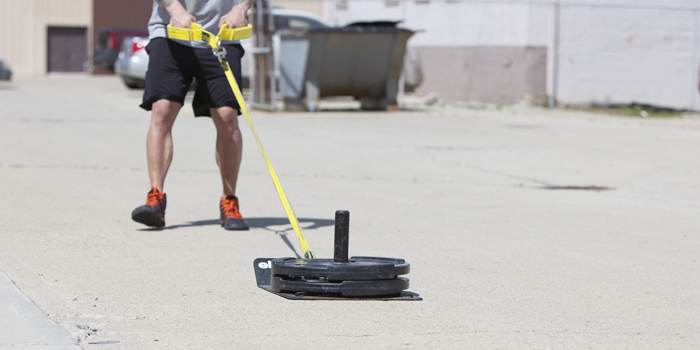
Most people will put a sled on either at the end of a lower body workout to help with recovery or on non-training days to go for long walks to increase work capacity. There may be a number of other reasons to use a sled, but these are the most common. We throw some weight on the sled, strap the belt on, put the headphones in, and just walk until we can’t walk anymore. But is that all there is to this movement? While most will likely try to think of anything other than the fact that they’re pulling a sled while doing so, I couldn’t help but recently pay attention to how everything in the posterior chain was being recruited. When I put clients on this, a handful of them always come back with their calves on fire, some will complain about their low back pain, and a few will come back feeling exactly what I told them they would feel. So what gives? The mind-muscle connection and firing patterns.
RELATED: Backward Sled Pulls for Quad Size and Strength
While many courses cover the topic, I feel that the reflective performance reset (RPR) course I took with Cal Dietz reviewed it the best. A firing pattern, in a nutshell, is the order in which you recruit your muscles to execute a task. In an ideal world, we would all fire the same way, but our lifestyles tend to make certain muscles strong and others get left behind, so the brain then resets firing patterns to make use of the strong (favored) muscles, ultimately leaving the weaker ones left to become even weaker. While the body is incredibly smart and amazing, it’s also incredibly dumb. This rewiring, while good in a short acute phase so as to protect against injury, left unchecked eventually gives rise to serious pain or biomechanical problems later down the road that can hinder performance, or at worst be a cause for surgery. What is there to do then?
Well, first we have to understand a saying given to me by my friend Dr. Serrano: “No chiropractor, massage therapist, or whatever doctor ever fixes anything. The most they can do is create the environment between the brain and body where a fix can happen. That fixing mechanism is corrective movement or exercise.” Of course, I had to correct some of the English in that when it was given to me, but it stands true still. Now, some issues would require referring out to a specialist before corrective movement can take place, but most times a good coach who knows about proper biomechanics should be able to teach and cue correct firing sequences. It's a bonus if they have also taken the RPR courses and can save time by using “reset” points on the body to restore proper patterns. Still, most people would do fine just by paying attention to their muscles while moving.
What does this all have to do with sled walking? Most people don’t walk correctly! Most people will simply plop their feet down in front of one another like a muppet to get to where they need to go, ignoring the beauty and strength that their posterior chain has to offer. Let's look at the video in this article. You can see in the first clip I try to mimic how most people will walk with a sled tied to them (or really any time they walk). The fleet plop, one by one. This is the pattern that will have people coming back to me with their feet cramping and calves on fire because they are pushing themselves forward with their toes. What can make it worse and cause the low back pain some people encounter is also walking with their lumbar curved, shutting the glutes off, and putting the work now in their erectors to walk a heavy load a long distance. Crampsville.
So what I try to teach when sending someone on the walk of pain is to start the first 30 to 50 steps driving their heels into the ground and pulling themselves forward with their hamstrings like a lying leg curl. Once they get that down, I tell them to grip the ground with their big toe each step, effectively recruiting more of their posterior chain during this exercise. Not so mindless of a movement now, is it? The lumbar curving is a bracing and breathing problem, and I’d rather not make this longer than it already is, but ask your coach how to breathe and brace properly to solve that. If you can get this firing pattern down you will quickly feel your hamstrings and glutes light up. Not only is it a good exercise for those muscles, but you will now also be reprogramming yourself to walk properly. Notice how as soon as you take the sled off you feel like you are running everywhere while walking. That won’t happen if you sled walk the wrong way; you’ll just be on the floor rubbing your calves.
Bonus tip
In the second part of the video (above), I show a trick I like to use on myself when doing sled walks at the end of a lower body workout. Any guy worth a damn in the gym is going to have strong and tight external rotators of the femur. While it’s good for some things, ignoring the internal rotators will lead to problems—such as low back pain and anterior pelvic tilt—and lends a hand to almost all the other ailments we hear strong squatters have. The corrective exercises for the internal rotators are boring as hell and I bet even fewer people do them than those that do the hand extensor exercises that resolve a ton of elbow issues. So, while sled walking and making sure I still walk heel to toe, I internally rotate my feet for brief periods of time just to help strengthen and balance them out with all the work the external rotators during in the training session. I don’t have anything to back this up and I don’t know if it is an effective dose to help balance anything out. But I do know that when I walk like that, I feel exactly the muscles working that I wanted to work. So until I learn otherwise, this will stay in my regimen.
I hope this helps some of you and gives you plenty to think about. Try sled walking out this way and tell me what you think!
Jance Footit, BSc, is the owner of 5 Rings Barbell. He is a coach who happens to be an athlete—not the other way around—and is involved in powerlifting, weightlifting, strongman, and Highland games. Footit is the inventor of the standing back extension machine made by Edge Fitness Systems.










I pull my sled usually walking forward and backwards, sometimes my low back gets real tight after. An additional advice? Do you think it’s the forward or the backwards?
No other movements really bother my lumbar.
Thank you
Will do